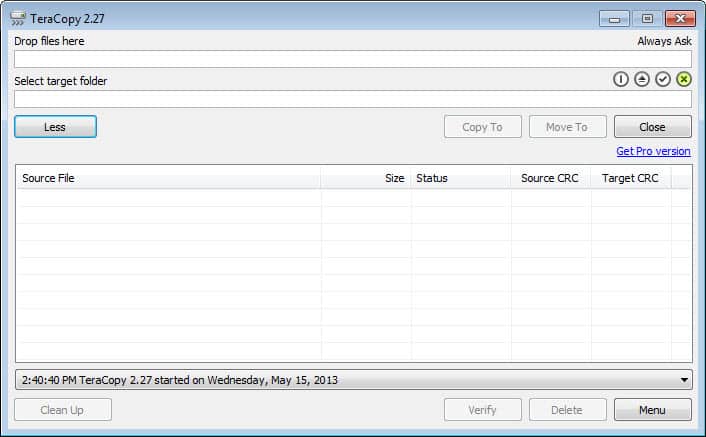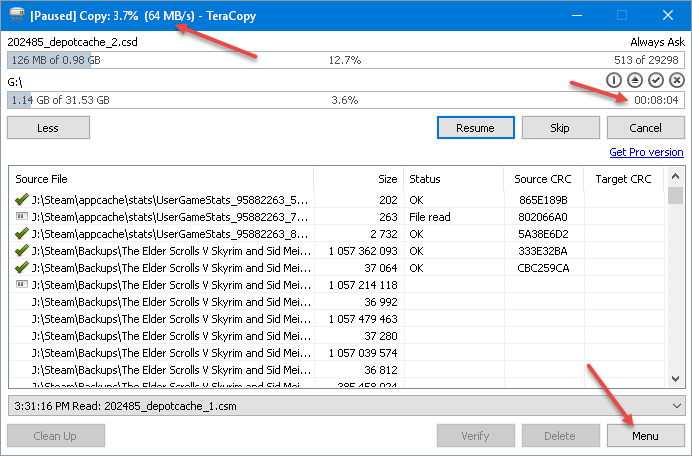

#Teracopy verify iso
All the official Windows ISO images will have an SHA-1 hash listed somewhere online which you can then compare against to see if the one you downloaded is identical to the original. A prime example is ISO images for operating systems like Linux and Windows.
#Teracopy verify download
A couple of popular hash algorithms are MD5 and SHA-1 and you will sometimes see these values listed on website download pages. If even one byte in the file changes, the value given when the check is run again will be different. Every file has unique data contained within it, and when you apply a certain algorithm called a “cryptographic hash function” to it, a string value is returned which is only valid for that file in its current state. Or you can verify a file’s integrity by checking its hash value. One of the ways you can identify whether a file has been changed from its original state is to check its digital signature. This could either be by the site you are downloading from, corruption due to errors in the download process, an individual who has uploaded the file for you, or possibly the most dangerous, the file has been infected by malicious software.
#Teracopy verify manual
FFS also has a website with a manual and a user forum.When you download a file from the internet, quite often you cannot be 100% guaranteed that the file has not been changed in some way from the original.

There is a bit of a learning curve to using FFS but once over that hump, it works smoothly every time. I pretty much never have one fail to copy over correctly.įFS is also what I use for backing up my data drives. If, for any reason, a file transfer fails, FFS will post a report at the end of the operation listing which files, if any, failed to transfer over correctly. I made this "hack" first when using FFS in Windows (pardon my profanity) and I now use it in Linux with the "hack". Change the word "false" to "true", then close the file. After installing FFS, go to your /home screen, show hidden files, the use Search to find globalsettings.xml. There is a simple, unauthorized "hack" one can make to it to verify copies it makes. I use a folder/file Syncing program called FreeFileSync (FFS). It's not intended to ensure the copy you have is exactly the same as the original author had before you acquired it. All Teracopy was ever intended to do was copy a file that you already have to another location of yours, then verify that the copy made is exactly the same as the file you already had. If you like this app then it can be installed with: I then checked the repos and it looks like ultracopier is in the Mint repos. I checked the website and it listed Ultracopier. It's just a good way of assuring yourself about the integrity of the newly copied or transferred files.Īh, ok TeraCopy is checking for corruption during file transfer. As for as I know, TeraCopy creates the checksums on-the-fly, then copies the files and compares their checksums to the original ones. I am not thinking about downloads, but local file transfers on the computer. There is a big difference between verifying file integrity from the author's hands and verifying that a file isn't a corrupted download. If TeraCopy is producing both checksums (before copy and after copy) then TeraCopy could be producing a checksum of a hacked file and you won't know the file was a hacked copy of the author's file. Is that what TeraCopy does? Or does TeraCopy simply create a checksum before copy and then compare that to another checksum TeraCopy produced from the downloaded file? The difference is that someone can replace the author's file on the server with a hacked copy and the user won't know the difference without the author's checksum. Now, in order for TeraCopy to do what I'm assuming it does, it needs the checksum that the author produced and then match that checksum to the file after you have received it. If the checksum the author has produced does not match the checksum that you have after receiving the file, then the integrity of said file cannot be confirmed. In order to verify that the file you received is an exact copy of the file as it was when it left the author's hands, both you and the author need a matching checksum. I'm not sure TeraCopy did what you think it did. Is there any way to make the built-in file transfer utility in Nemo do this? Or would you need a completely different file manager? This feature is something I miss on Linux. It does this by CRC checksumming them on the fly.


For Windows, there is this nifty program called TeraCopy, which automatically verifies the integrity of all files that are copied/transferred.


 0 kommentar(er)
0 kommentar(er)
